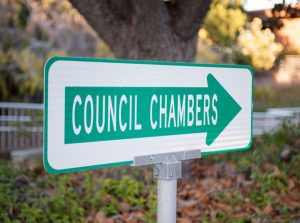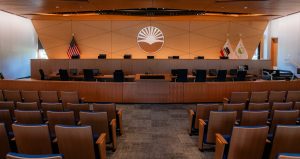The El Camino Real Specific Plan is a massive undertaking that outlines the City’s guidelines for future development along the El Camino Real corridor in Santa Clara. It was a plan that took years to complete. It’s designed to make one of the main arteries through Santa Clara both visually appealing and functional.
“Our vision for El Camino Real corridor was to transform it from the low intensity, auto-oriented commercial uses — it was a mix of restaurants and some retail, but not a lot — to have more of a mixed-use environment with four or five story residential buildings with some ground floor commercial,” said Andrew Crabtree, the Director of Community Development for the City of Santa Clara.
El Camino Real was first identified by the City as an area for redevelopment in 2010. However, the housing downturn in the early 2010’s made the need for a specific plan less urgent. Crabtree says as the economy picked up and developments increased, it became more apparent guidelines for development on El Camino Real were needed.
“The City Council directed us to go and start the specific plan process, really wanting to see a cohesive, urban design approach for the corridor. Whether that’s the pedestrian facilities, the sidewalk, landscaping along the frontage, or where they back up the residential neighborhoods and what that interface looks like,” said Crabtree.
City planners began developing the El Camino Real Specific Plan in late 2017. They spent years on community outreach and plan development. What they created is a plan that will include safe passage for bicyclists and pedestrians, while still being driver and public transit friendly.
Good for Cyclists, Pedestrians and Commuters
Ultimately, each side of El Camino Real will include a 10-foot-wide easement in front of buildings to allow space for pedestrians. There will also be 4-feet of space next to the easement for landscaping, including trees.
On the street, there will be a protected bike lane for cyclists and bus boarding islands to allow for easy access to public transportation. The plan also calls for six lanes of traffic — three in each direction — as well as a dedicated left turn lane where needed.
To make sure the area suited as many forms of transportation as possible, the City consulted with multiple groups including the Silicon Valley Bicycle Coalition (SVBC). The SVBC says while the ultimate plan looks good, the rollout might be cause for concern.
“As planned, the proposal would majorly improve safety for people walking and biking on El Camino Real by providing continuous, protected bikeways, wider sidewalks, transit boarding islands, better signage and lighting, more trees and greenery, and more,” said an SVBC representative. “The one concern we have is that the protected bikeway will only be built as redevelopment occurs. Though the plan proposes to remove parking to facilitate better connections for people walking and biking, that will only be done with redevelopment, which will take years. SVBC wants to see these changes happen sooner to ensure that El Camino Real is safe for everyone, no matter how they get around.”
The City says it’s doing what it can to make the transition smooth, but a complete change can’t happen all at once.
Parking Questions
As mentioned, the City will eliminate street parking along the corridor except for a few key places.
“We did a lot of engagement and found that there were really three areas where the businesses didn’t have another place to park. So, until those sites redeveloped, we know that we’re going to be allowing street parking,” said Reena Brilliot, City of Santa Clara Planning Manager.
Some community members have expressed concern about how the removal of parking will impact traffic and businesses as more mixed-use housing and retail are introduced, but Brilliot believes the effect will be minimal.
“I think that by creating a mixed-use environment, where you have retail and you have housing, there’s a lot of trips that are synergistic,” said Brilliot. “So, the coffee shop downstairs is probably going to be supported by many of the residents who live on El Camino Real. So, we definitely are taking advantage of the mixed-use character of El Camino Real, but each of these [new developments] will be providing for their own parking.”
Decreased Retail
When the entire El Camino Real Specific Plan is in place, the corridor is expected to lose approximately 395,000 sq. ft. of retail space. During the Planning Commission’s final evaluation of the plan on May 10, 2021, Commissioner Ricci Herro warned the planners to be wary of cutting retail space.
“My real concern is the propensity to lose more retail than we’ve already lost,” said Herro.
City planners point out approximately 1.8 million sq. ft. of retail space will still be present. They say the decisions were not made lightly.
“We engaged a retail consultant that was heavily involved with helping us place retail on the corridor,” said Brilliot. “We emphasized retail where we knew retail would be successful, related to visibility, and where we know what retailers are looking for. That’s something that I think we feel really comfortable with. We’ve gotten a lot of expertise into the plan.”
Impact on Residents
One of the key development plans for El Camino Real is the introduction of more mixed-use properties. That means retail downstairs and three to four floors of residential above. The plan calls for the addition of approximately 6,200 housing units, including a large amount of affordable housing.
People who live around El Camino Real are concerned about the increased traffic and population density on El Camino Real. City of Santa Clara Assistant Attorney Alexander Abbe says Santa Clara has to develop somewhere to meet state standards.
“There are severe consequences to the City if we do not take sufficient steps to further the development of housing for all income types; not just above moderate, but also moderate, low, very low-income housing. There’s certain state funding we will lose,” said Abbe during the May 10 Planning Commission meeting. “There’s a number of Draconian penalties including lawsuits against the City and fines against the City if we do not take aggressive steps to address the housing disaster that the state is facing. The El Camino Real is one of the most underutilized corridors; it’s a prime opportunity for the City to redevelop some underutilized sites.”
If Santa Clara does not meet the housing thresholds set forth by the state, it could lose the freedom to approve or deny future affordable housing development applications.
The Santa Clara City Council will review the El Camino Specific Plan at a Special Meeting on Tuesday, June 15.












Cross El Camino, aka “El Canyon Real”, off the go-to list. If you don’t live in one of the cubical apartments, you can’t, and don’t want to get there. Include the apparent demise of small businesses in the state, and what is now the attraction?